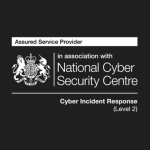Cyber attacks have become a reality for businesses across the globe, and the rate of cybercrime is only expected to grow. It’s estimated that the cost of cyber-crime will reach $10.5 trillion (£8.5 trillion) by 2025.
Organisations need to prepare for this new reality, and that’s where incident response comes in.
What is Incident Response?
Incedent response is the process by which an organisation handles a cyber incident. It involves following a set of pre-determined procedures and protocols to identify, contain, recover and learn from an incident quickly and effectively.
The main aim of incident response is to limit the impact, recovery time and cost following an attack or breach.
Why is Incident Response Important?
Incident response is important for several reasons:
Limits the impact of an incident – By quickly identifying and containing an incident, it can prevent data loss, and reduce costs and reputational damage.
Reduces downtime – Having incident response measures in place can help your organisation return to business as usual as soon as possible.
Prevents future incidents – Being able to identify the cause of the incident can help prevent similar incidents from occurring in the future.
Helps with compliance – Various Regulations and Standards, such as the GDPR (General Data Protection Regulation) and PCI DSS, require organisations to have incident response plans in place.
Build customer trust – Having well-executed incident response plans in place demonstrates to customers that you take security seriously and are proactive in protecting their data.
What is an Incident Response Plan?
An Incident Response Plan is a document that outlines the procedures and protocols your organisation should follow in the event of a cyber incident. Having this plan in place enables your organisation to respond and act quickly, minimising the impact of the incident.
An Incident Response Plan follows six steps:
1. Preparation
The first step of an Incident Response Plan involves outlining what you will do in the event of an incident. You should ensure that all employees have a level of incident response training and that all relevant parties are aware of their roles and responsibilities.
2. Identification
This step involves identifying if a security incident has occurred.
If an incident has occurred, you will need to determine the scope and nature of the incident, identify any data that may have been affected, and the potential impact of the incident.
3. Containment
Next, you’ll need to limit the current damage and prevent any further damage by taking immediate action to contain and stop the spread of the incident. This could include isolating affected devices and networks, and making sure the attacker is unable to access any more of your systems.
4. Eradication
You will need to work to remove the cause of the incident and start to restore affected systems and devices. This could include removing malware, patching any vulnerabilities or reinstalling affected systems.
5. Recovery
Once the threat has been contained and removed, you can start to restore any affected systems and devices, and get back to business as usual.
Even after you’ve recovered from the incident, it’s important to remain vigilant to any abnormal behaviour, in case the threat hasn’t been completely removed.
6. Lessons Learned
The final step of an Incident Response Plan is to document the incident, including what happened, what worked well, and what could have been improved. This includes identifying any areas for improvement in the incident response plan, and taking steps to prevent similar incidents from happening in the future.
What is an Incident Response Playbook?
An Incident Response Playbook gives you a set of checklists and documents for managing and responding to cyber incidents.
It’s similar to an incident response plan, but provides you with more detailed instructions for handling specific types of incidents.
These incidents could include:
- Phishing attacks
- Ransomware attacks
- Malware
- Distributed Denial of Service (DDoS)
The Playbook should outline the step-by-step actions to be taken in the event of an incident, and the roles and responsibilities of different individuals involved in the incident response process.
Like an Incident Response Plan, the goal of an Incident Response Playbook is to provide a clear and efficient approach to managing incidents, so you can quickly and effectively control the incident, and contain the impact and damage caused.
These Playbooks should be reviewed and updated regularly to reflect changes in the organisation, new threats and risks, and lessons learned from past incidents.
Who Handles Incident Response?
Incident Response is typically handled by a dedicated Incident Response team within your organisation. Smaller organisations may have designated individuals in their IT teams, but they can often lack the skills and knowledge needed to effectively handle an incident.
Having an incident response team and a regularly tested Incident Response Plan can save an average of $2.66 million (£2.2 million).
In the event of a cyber incident, you want to have peace of mind knowing that the incident is being handled by experts. Having the right qualified team in place is vital when it comes to reducing the impact and cost of an incident, and being able to get back to business as usual as soon as possible.
3B Data Security – Your Incident Response Experts
The team at 3B Data Security have extensive experience and expertise gained from conducting a wide variety of incident response and data breach investigations ranging in size and complexity.
3B Data Security have developed a proactive incident response retainer service. This aims to support clients with a range of elements that will make successful cyber-attacks less likely, prepare your organisation to deal with an incident more effectively and efficiently and provide assurance that you can get the help you need, when you need it.
The service is tailored to your organisation and allows you to rest easy knowing help is always on hand and proactive measures are taken to help reduce risk in advance.
3B Data Security are approved under the recognised UK national body CREST Cyber Security Incident Response (CSIR) scheme. Our consultants even helped design the CREST Certified Incident Manager (CCIM) accreditation.
Find out more about our Incident Response Retainer Service >>
If you think you’ve suffered from a cyber incident and need immediate support, you can get in touch with our team now.
We operate 24x7x365 across the UK and globally.
Call us on 01223 298333 or out of hours on 01223 298338 or email us at IR@3BDataSecurity.com






